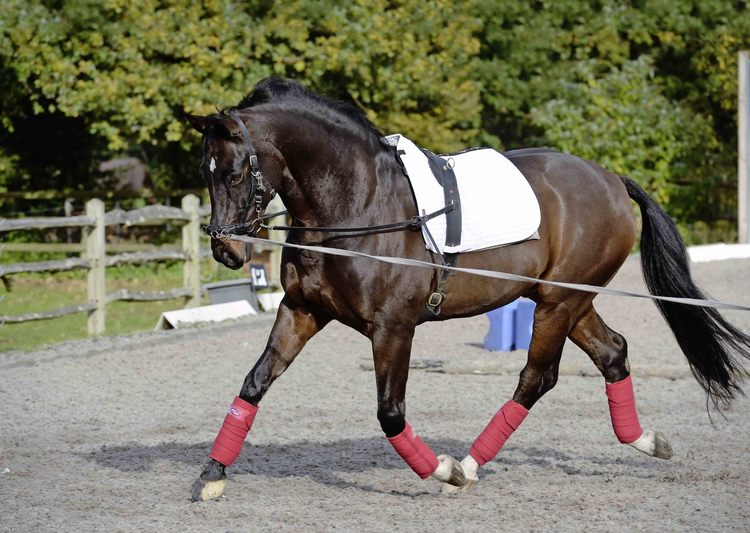Lunge reins or lines should be strong, well made and thick enough for the trainer to hold properly. Cotton-based webs or cushioned webs are best because in times of crisis when strength is needed, the rein does not slip through the trainer’s hand or cause friction burns as some materials can, even through a pair of gloves.
The fastening should ideally be buckled leather with a swivel just below the buckle so that the rein does not twist. If the lunge cavesson has a swivel the lunge rein does not necessarily need one as well. If the fastening is a clip then a good quality substantial trigger clip is best and it should also have a swivel just below the trigger. Nothing is more dangerous or frightening than a strong horse suddenly escaping as the clip on your lunge line gives way under the strain.
It is very important that the lunge rein is a suitable length for the size of horse being lunged. The usual length of standard reins available in tack shops is 21 ft or sometimes 24 ft. These lengths are fine for ponies or cob-size animals but for a large horse to work on the lunge without unnecessary strain on the joints, the length should be about 30 ft. This enables the horse to make a larger circle around the trainer; working on a small tight circle for any length of time is a great strain on joints and limbs, particularly the hocks.
Tubular web
This rein is normally made in white, fairly soft cotton tubular webbing with a buckle and swivel fastening. A very traditional lunge rein but obviously anything in white is not as practical in these modern times as all the coloured cotton webs available. Also, it is not as resilient to being left out in a wet sand school as nylon!
Continental Web
These reins can be made of four-, five- or six-cord continental webbing in brown or black. This is the same material that continental reins are made from and it comes in 1 1/2in, 5/8 in, 3/4in or 1 in thicknesses. Saddlers can buy this material by the metre and make up any length of lunge, long or draw rein that you require with whatever fastening or hand part you feel most comfortable with.
Cushioned web
This material comes in a variety of colours and is normally made up by major manufacturers in either 21 ft or 24 ft reins. It gives the handler a soft, but very substantial, flexible lunge rein to work with. Make sure the clips are good quality as this could be a potential weak spot.
Lungeing Rollers
Leather lungeing rollers
These rollers can be expensive but if they are well maintained are well worth the outlay. The best of them have a proper tree in the pad just like a driving saddle so that the tree can rest on each side of the horse’s withers and there is a gap that clears the spine. The rollers usually come with a matching saddle pad and leather girth like a dressage girth but, if they do not, an ordinary leather dressage girth will fasten it just as safely. The more D rings on each side of the roller the better, then you have a choice of levels at which to attach various pieces of schooling equipment.
TO FIT: Even with a tree in the saddle of your roller it is best to place a small pad under the roller and pull it well up into the roller’s gullet to ensure that it is a comfortable lit. Girth the roller up evenly so that the buckles are at the same level on each side of your horse. It does not have to be as tight as a saddle girth but tight enough not to slip round.
Webbing Lungeing rollers
This type of roller is usually sold as the roller only; you either buy a new webbing girth to fasten it or use one you already own. These do not have a rigid tree in them but are nevertheless fairly substantial and have a variety of ring options.

